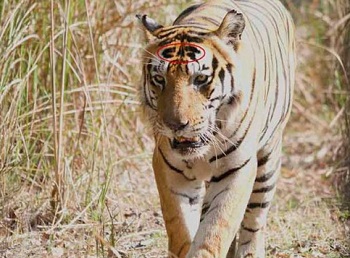Tigers: India
This is a collection of articles archived for the excellence of their content. |
Contents |
1973: Project Tiger
India Today December 29, 2008
The Rs 230-lakh Project Tiger was a Union Government and the World Wildlife Fund joint endeavour in 1973, to check immediate threats to the national animal. “It registered a marked increase in most animal populations in the first decade” (India Today, December 1983). With 1,550 sq km under its canopy, including 15 sanctuaries and national parks, the project cordoned off a third of this land for conservation activities and demarcated the rest as a buffer area, relocating the villages around.
1999-2015: Population

2006-2014: High growth
Jan 21 2015
2,226 now: Tiger numbers grow by 30% in 4 years Camera trap and DNA sampling methods used in tiger census
Vishwa Mohan
There are more than 2,200 tigers in India's forests, the latest census reveals, indicating a sharp 30% rise in four years that'll come as a big boost to India's conservation efforts. The census, held in 2014, found evidence for 2,226 tigers, compared to 1,706 in 2010.
The southern states of Karnataka, Tamil Nadu and Kerala in the Western Ghats landscape recorded nearly one-third of the country's total number of big cats. Karnataka continues to have the highest number of tigers in India, itself home to 70% of the world's tiger population.The Mudumalai-BandipurNagarhole-Wayanad forest complex in Western Ghats holds the world's largest tiger population, with 570 tigers. If one compares the 2006 tiger census, when mod ern methodology was adopted for the first time, revealing a tiger population of just 1,411 -the overall increase across the country is a phenomenal 800-odd tigers in the past eight years.
Releasing the 2014 data on Tuesday , Union environment and forests minister Prakash Javadekar said, “We must be proud of our legacy . We have increased the number of tigers by over 30% from the last count (in 2010). “ A total of 3,78,118 sq km of forest area in 18 states, having tiger population, was surveyed during the census that used `double sampling' approach including ground survey and remote camera trapbased capture and recapture technique. Besides, scat DNA sampling method was also used for corroboration in many forest areas.
More than 9,730 cameras were used in the exercise, carried out by National Tiger Conservation Authority in collaboration with the state forest departments, national conservation NGOs and Wildlife Institute of India.
The exercise resulted in 1,540 individual tigers being photographed -making it the most authentic report on tiger population in the country.
The report shows that the tiger population has increased in Karnataka, Utta rakhand, Madhya Pradesh, Tamil Nadu and Kerala in the past four years, while it has decresed in Odisha and Jharkhand.
Poaching: 2012-2014
The Times of India, May 15 2015
In 2012-14, poaching has resulted in the deaths of 74 tigers in the country. The data for poaching, including seizure of tiger organs, shows that 23 tigers, or about 31% of the total, were killed inside tiger reserves while 51 were killed outside these reserves. A state-wise analysis of the data shows that the highest number of tigers were killed in Maharashtra followed by Karnataka and Madhya Pradesh, each of these states witnessing over 10 deaths in these three years Source: Ministry Of Environment, Forest And Climate Change, * including Telangana.
Predator attacks
February 19, 2015
Man-eater killed by a joint Kerala-Tamil Nadu Special Task Force in the Gudalur forests along the Nilgiris-Wayanad border after attempts to tranquilise and relocate it for eight days failed. The tiger claimed two victims. National Tiger Conservation Authority norms were allegedly overlooked.
December 29, 2014
A relocated man-eater was killed in Khanapur Taluka of Belgaum, Karnataka, by the state Anti-Naxal Force after it mauled a pregnant woman in the Bhadra Wildlife Sanctuary in Chikkamagaluru district.
August 20, 2014
Tiger shot dead in Chichpalli range of Chandrapur, Maharashtra, by sharpshooters. Seven people had been mauled to death by tigers in six months in Pombhurna village. There was dispute over whether the right man-eater was killed.
December 6, 2013bb
Man-eater was tranquilised and caged in Bandipur, Karnataka, by veterinarians tracking it. It had claimed three lives in surrounding villages. It has been relocated to the Mysore zoo.
5. December 2, 2012
Tiger was shot dead in a coffee plantation in Moolamkavu, Wayanad, by Special Task Force officers. Its victims were a dozen cattle. Maneka Gandhi claimed that the shooting was a "cause to wind up the Wildlife Department" as the tiger was not a man-eater.
Famous tigers of India
The Times of India, 14 Jul, 2015
Tigers like Ranthambore's T24 have been hitting headlines of late for attacking humans. Here are famous big cats from around the country.
Machli

One of Ranthambore National Park’s most famous tigers, Machli (T16) has been the subject of a number of documentaries and films and received a clutch of awards. She’s known as the ‘Queen of Ranthambore’ and the ‘Lady of the Lakes’ and once dominated the entire jungle. A You Tube video of her battling and vanquishing a 14ft mugger has more than 5 million views. She’s now 19 years old, weak, toothless and possibly blind in one eye, and the park officials feed her to keep her alive.
Munna

Kanha Tiger Reserve’s most famous residents is a tiger called Munna, who can quite easily be identified by his stripes. The marks on his forehead seem to spell out ‘CAT’ and tiger lovers say the ‘PM’ below stands for prime male. Munna has a reputation for following safari vehicles until they pull off the track.
Bamera Male

The son of Bandhavgarh National Park’s best known tiger B2 or Sundar, who died in 2011, this dominant tiger is known only as Bamera male. The story is that he left the reserve he was born in but returned a few years later to battle his father and take it over.
Shivaaji

One of Tadoba Andhari Tiger Reserve’s most famous big cats is the dominant male, Shivaaji. The 13-year-old tiger, known for his bulk and aggression, can usually be seen in a 50sqkm area of the southern I Kolsa range of the park.
An increase, Uttar Pradesh



Rise in No. of tigers in Uttar Pradesh
The Times of India TNN | Jul 27, 2014
LUCKNOW: Camera traps have shown more tigers in the core area of Dudhwa tiger reserve this time. The initial estimates for two years, 2011 to 2013, have shown 72 to 80 tigers in the core area of the reserve.
Tiger census 2010-11 had counted 118 tigers in Dudhwa reserve. "The final count this time might be around 125," said PCCF (wildlife), UP, Rupak De.
The findings have been sent to the Union ministry of environment and forest for screening, said the official.
Camera-trapping exercise has been done for Kishenpur wildlife sanctuary and Dudhwa national park which form core of the reserve. Initial findings have also come for Pilibhit forest division which is now a separate reserve.
In all, 72 to 80 tigers have been counted in these areas. Once figures for Katarniaghat wildlife sanctuary, North and South kheri forest division come, tiger numbers might go up to 125. The improved census technique could have resulted in more tigers getting recorded in camera.
It was an 'intensive' exercise as a pair of cameras was installed every 1.6 sq km of the core area. A pair of cameras was installed at 65 identified points in Kishenpur and at 206 identified points in Dudhwa national park.
The height at which cameras were mounted was also altered to record cubs, two-year old and less.
About a dozen new cubs have been recorded in camera.
At least 382 photographs have been downloaded from cameras installed in Kishenpur and Dudhwa national park.
Many of these photographs, said officials, could be 'repetitions' which is why the photographs would be screened. Tiger census is on since November 15 in the reserve.
UP has a major tiger population in Dudhwa tiger reserve comprising Dudhwa National Park (680 sq km), Kishenpur Sanctuary (204 sq km) and Katarniaghat Wildlife Sanctuary (440 sq km); Pilibhit (720 sq km); North Kheri (350 sq km) and South Kheri (460 sq km).
Smaller tiger populations are present in Bijnor forests in west and Suhelwa (Gonda-Bahraich) and Sohagibarwa wildlife sanctuaries (Maharajganj) in east.
Tiger reserves in India: Valuation
Jan 22 2015
6 tiger reserves worth Rs 1.5L cr: Valuation study
Vishwa Mohan
In a first of its kind exercise, India has conducted economic valuation of six of its tiger reserves and placed their value at Rs 1,49,900 crore. The study has also noted that these six reserves have been generating annual monetary benefits worth Rs 7,970 crore. The six tiger reserves which were surveyed for this study are Corbett, Kanha, Kaziranga, Periyar, Ranthambore and Sundarbans.
India has 47 tiger reserves covering over 2% of the area and approximately 10% of the recorded forest area. Latest tiger census shows that India -which is home to 70% of world's tiger population -has a total of 2,226 tigers.
The valuation study, executed by Indian Institute of Forest Management (IIFM), Bhopal, at the behest of the environment ministry's National Tiger Conservation Authority (NTCA), provides quantitative and qualitative estimates of benefits accruing from tiger reserves which include economic, social and cultural services.
“The study findings indicate that the monetary value of flow benefits emanating from selected tiger reserves range from Rs 830 crore to Rs 1,760 crore annually . In terms of unit area, this translates into Rs 50,000 to Rs 190,000 per hectare per year,“ said the summary of the report released simultaneously with the tiger census by the Union environment and forests minister Prakash Javadekar.
Buxa Tiger Reserve: "No sign of tigers"
Apr 27 2015
Krishnendu Mukherjee
The Wildlife Institute of India (WII) scientists who conducted a nationwide tiger census over four years have stated in their final report that they found no sign of tigers in the north Bengal park. “Though two tigers were identified in Buxa on the basis of scat-based DNA, our research team has found no tiger sign in the forest,“ says the report, which was recently submitted to the ministry of environment and forests According to the findings, the Buxa tiger population is “declining“ and needs special attention. The Dehradun-based research institute has also questioned the authenticity of the scat samples sent to it by the Bengal forest department.“We took the GPS coordinates of the scat samples from the state foresters and sent our research team there,“ said Y V Jhala, a senior scientist at the institute. “But the team didn't find any tiger sign in and around those areas. So, we could not authenticate the origin of the scats.“
Earlier, there were allega tions that such scat samples were collected from a wildlife rescue centre located near the tiger reserve. A cameratrap exercise, started in Buxa more than a year ago, has also failed to capture any image of tigers. The same exercise, though, has brought to light the existence of rare and elusive animals such as the clouded leopard, marbled cat and Himalayan serow in the reserve.
A separate study by WII, however, has found the movement of about nine tigers in the corridor between Buxa and Assam's Manas Tiger Reserve.
Ranthambore National Park: Rajasthan






